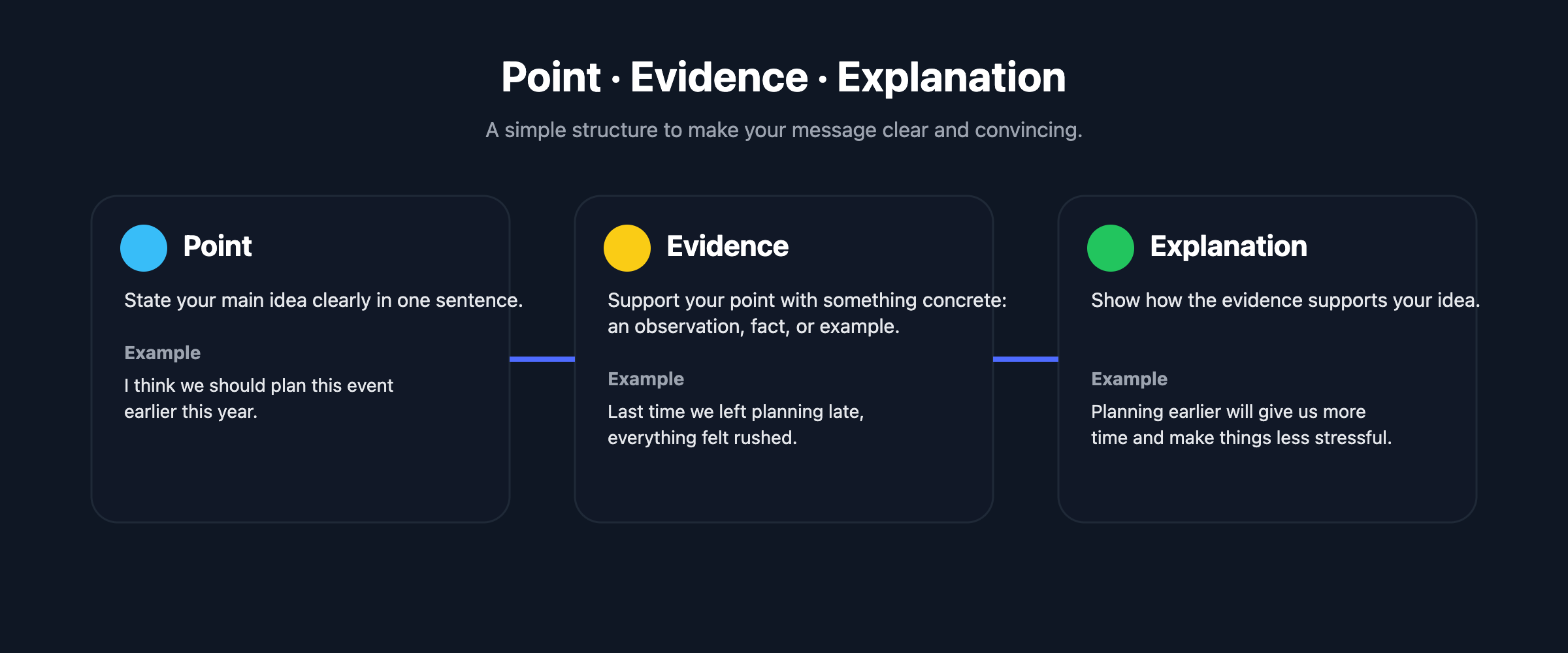To build trust and persuade others, you need to show that you know what you’re talking about and that your advice or ideas are grounded in real understanding. Demonstrating competence and credibility isn’t about showing off; it’s about making it easy for others to see why they should rely on your perspective. This involves supporting your ideas with evidence, sharing relevant experience, and being transparent about risks or trade-offs.
People are far more likely to trust your recommendations when you support them with something concrete. When you make a claim, back it up with a clear example, a relevant data point, or a brief story that illustrates your point.
A helpful approach here is the “Point, Evidence, Explanation” method:

This simple structure helps you organize your thoughts and make your ideas more convincing in any conversation. If you don’t have hard data, a real-world analogy or a quick anecdote can be just as effective. The key skill is being able to quickly recall and share relevant support for your ideas in conversation. Here’s how this looks in a real conversation:
Jessica: I think we should start the community event an hour earlier this year.
Nova: Why do you think that would help?
Jessica: Last year, when we started earlier, more families were able to attend before dinner time. I helped organize the event, and we saw a noticeable increase in family turnout.
Nova: That makes sense. Is there anything we should watch out for if we change the time?
Jessica: The only downside is that some volunteers might have trouble arriving earlier, but we can check in with them ahead of time and see if anyone needs help with setup.
In this example, Jessica uses the “Point, Evidence, Explanation” method, briefly references her relevant experience, and acknowledges a potential trade-off. This approach helps Nova see that Jessica’s suggestion is well thought out and trustworthy.
Mentioning your relevant experience can demonstrate credibility and reassure others that you understand the context. When mentioning relevant experience, it’s important to keep it brief and focused. For example, if you’re helping a friend plan a road trip, you might say, “When I drove that route last summer, leaving early in the morning helped us avoid most of the traffic." This shows you have practical knowledge without derailing the conversation with a long story.
The most effective references are relevant, recent, and relatable. Share experience that directly connects to the current topic, use examples from the last few years if possible, and frame your experience in a way that matches your audience’s situation. Summarize your experience in a sentence or two, then pivot back to the discussion at hand. This keeps the focus on the current issue while still establishing your credibility.
True competence means understanding the full picture, not just the upsides. When you openly acknowledge risks or trade-offs, you show you’ve thought things through and aren’t just selling a one-sided story. This builds credibility because people see you as realistic and trustworthy. State the main benefit, name a potential downside, and suggest how you’d address it. This approach demonstrates that you’re not ignoring challenges and that you have a plan for handling them. For example if you’re recommending a new board game for game night, you could add, “It’s a lot of fun, but the rules take a few minutes to learn. I can explain them before we start so it’s easier.”
By weaving together clear evidence, relevant experience, and honest discussion of risks, you naturally demonstrate both competence and credibility. This makes it easier for others to trust your judgment and follow your lead.
